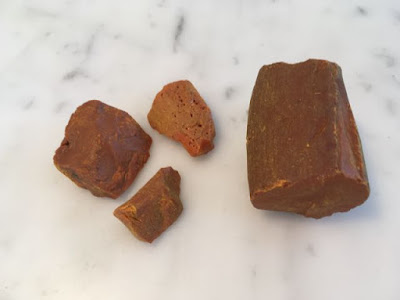Following on from the previous post about a 7-colour earth palette, I looked at the 'extras' I carry in my little
Pocket Palette. (Note all watercolours are Daniel Smith)

I normally set it up with 14 of my Ultimate Mixing Colours as picture left (more information
here and
here), but my 'extras' version had hansa yellow light, phthalo blue RS and pyrrol scarlet (since they are not in my regular palettes and I sometimes need to demonstrate them) and a whole pile of earthy colours - almost a perfect earth palette in fact.
It had a number of pigments that I love for different reasons, and may want to paint with along with my regular palette - the basic 20 colours that I generally use. The yellows in my regular palette are Hansa Yellow Medium, Quinacridone Gold, Goethite and raw umber.
The extras were -
yellow ochre - which I like to use for landscapes or portraits
raw sienna - which mixes into a grey rather than a green with blues - good for skies, though also for skin-tones
transparent red oxide - which I love for its gorgeous burnt orange colour and crazy granulation
piemontite genuine - which is fabulous for rusty effects with transparent red oxide
cobalt blue - which is a beautiful colour that I don't use much (outside Santorini!) and want to get to know better
cobalt turquoise - which is lovely for copper effects and the sea
green apatite genuine - which is gorgeous for foliage, and is a multiplicity of greens in one pigment
serpentine genuine - which is perfect for grassy meadows
graphite - which intrigues me, though I don't often use it...
sodalite genuine - which has a little deep blue colour but lots of granulation
lunar black - which is the only black watercolour I use - fantastic granulation and texture

I wanted of keep most of these colours in their natural form, so they are still available when I need them, but turn the palette into a full stand-alone granulating earthy palette to paint with rather than just an extras palette.
So I added buff titanium, Indian red and cerulean chromium from my regular palette, instead of the hansa yellow, pyrrol red and graphite grey. I have also added the gentle potter's pink that is a long time favourite of
Liz Steel that I have rarely used, as a granulating dusty rose (instead of the powerful phthalo blue RS that would overpower this new earth palette). It will mix gentle purples with cobalt blue. Purpurite genuine was another possibility here.
Cobalt blue is arguably too bright for this palette, and Blue apatite genuine would be a very fitting alternative, but I do want to get to know cobalt blue better so it is staying :-)
Outside the 14-colour palette paint-out, you can see that up the top I have also painted the lovely earthy mix of Quin Gold and Goethite, (I guess that would be Jane's Granulating gold :-) and the mix of Transparent Red Oxide and Burnt Sienna (Jane's Sienna) that are both in the 7-colour palette I posted about
here.
Below are Graphite Grey, Hematite Genuine and Jane's Grey, which are alternatives for the dark colours, with VanDyck brown over on the right.
If I were suggesting a 12-colour granulating earth palette, it would have my Granulating Gold mix instead of Yellow Ochre and Raw Sienna, my burnt sienna mix, Indian Red alone (without Piemontite or Potter's Pink) and a deep granulating brown such as Van Dyck Brown instead of Lunar Black. Though of course Blue apatite genuine and Jadeite genuine are also gorgeous :-) The basic triad of a yellow earth, Indian red and cerulean are the starting point. How many you add to it is all about personal taste and what other pigments you happen to have or to like.
Now it's time to go out and paint with my new granulating earth pocket palette...
I went to a park in Rozelle and chose to paint the rocks on the shore. Not a challenging subject with an earthy palette I'll admit! It worked fine, but don't like to be missing Jane's Grey from my palette. Sodalite is interesting but not actually as versatile as my grey mix. Nor do I like missing ultramarine to be honest, even though cobalt blue works in a similar though gentler way. Nor quinacridone gold or goethite. So what have I learnt? That I am very stubborn! I have favourites because I love working with them. Why change? It's important to experiment and test things out, even if one returns to the status quo.
I'll keep my earthy 14 colour palette made up of course, but will continue to use them as extras to my usual set.














